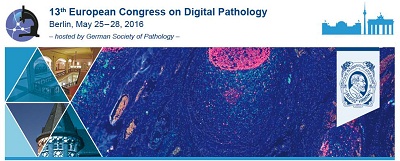Automated Image Analysis Of Her2 Fish Enables New Definitions Of Genetic Heterogeneity In Breast Cancer Tissue
Abstract
Introduction/ Background
Therapy decisions for breast cancer rely on human epidermal growth factor receptor 2 gene (HER2) amplification testing. The HER2 status of tumors is primarily established by immunohistochemistry; borderline (2+) cases undergo further testing by fluorescence in situ hybridization (FISH). Current guidelines state that HER2 amplification is determined from manual counts of HER2 and CEP17 signals in 40 nuclei per case with an additional 20 nuclei in equivocal cases. The definitions are based on expert opinion rather than on objective statistical inference; they are complex, involving different quantities and cut-offs all at once (the signal counts and their ratio, proportion of cells amplified) and hard to follow. Automated image analysis (IA) extracts data from hundreds of nuclei and can aid HER2 testing in borderline cases.
Aims
We therefore explored if objective, statistically-derived indicators of HER2 heterogeneity can be obtained from automated HER2 FISH IA data.
Methods
50 cases of female invasive ductal breast carcinoma with HER2 2+ immunohistochemistry status, evaluated by the standard manual FISH methodology, were subjected to IA. The IA, developed using StrataQuest (TissueGnostics,Austria), segmented and counted individual nuclei and HER2 and CEP17 signals. A range of 192 to 789 nuclei per tumor were evaluated by the IA. All segmented nuclei and FISH signals were inspected manually for quality assurance and accuracy estimates. Bimodality indicator (Ashman’s D) was computed for HER2 signal and HER2/CEP17 ratio in individual cells and included in factor analysis along with the data from manual and automated HER2 FISH analyses.
Results
No significant bias was found between the automated and manually corrected HER2 FISH nuclei or signals, obtained by IA. However, the manual HER2, CEP17 counts and HER2/CEP17 ratio were significantly underestimated by the automated procedure due to differences in cell selection in the techniques. By formal criteria (Ashman’s D>2), 5 cases were classified as bimodal by HER2/CEP17 ratio and 23 cases by HER2 counts. Of those, 3 and 18 cases, respectively, were not amplified according to the cutoff of HER2/CEP17<2 by manual procedure. Factor analysis of the data set extracted 3 intrinsic factors of variation, representing amplification, “polysomyâ€, and bimodality. Importantly, the factor scores could be seen as “purified†indicators independent of well-known interactions between the absolute counts of HER2 and CEP17 signals per cell and their ratios. Therefore, the tumor cases may be independently characterized by the three vectors. Remarkably, the distribution of the tumors by the bimodality factor scores revealed a distinct peak of “highly bimodal†cases, suggestive of the possibility of robust stratification of the patients according to the bimodality indicators. We conclude that analysis of continuous HER2 FISH data obtained by IA enables new strategies for evidence-based stratification of heterogeneous breast tumors. In particular, indicators of bimodality of cell distribution according to their HER2 FISH signals may be useful in detection of heterogeneous cell populations, along with the currently used criteria based on cell proportions at a certain amplification cutoff. While clinical validity remains to be tested, we suggest that detection of bimodal distribution of cells can serve as robust, evidence-based stratification and decision support tool, highlighting potentially heterogeneous tumors.
Downloads

This work is licensed under a Creative Commons Attribution-ShareAlike 4.0 International License.
Authors who publish with this journal agree to the following terms:
1. Authors retain copyright and grant the journal right of first publication with the work simultaneously licensed under a Creative Commons Attribution License that allows others to share the work with an acknowledgement of the work's authorship and initial publication in this journal.
2. Authors are able to enter into separate, additional contractual arrangements for the non-exclusive distribution of the journal's published version of the work (e.g., post it to an institutional repository or publish it in a book), with an acknowledgement of its initial publication in this journal.
3. Authors are permitted and encouraged to post their work online (e.g., in institutional repositories or on their website) prior to and during the submission process, as it can lead to productive exchanges, as well as earlier and greater citation of published work (See The Effect of Open Access).
4. In case of virtual slide publication the authors agree to copy the article in a structural modified version to the journal's VS archive.








